
I am on my annual pilgrimage to Reykjavík. A city in which I have lived and loved. A musical place, an arty place, endowed also with an ancient literature, the Icelandic sagas, for example. Warm hearted people too. The weather can be kind here in summer but in winter it is a different matter. Located on what I call the freeze-thaw fringe – as the Gulf Stream keeps the country relatively warm considering its latitude ‒ newly fallen snow may freeze. This is like walking on icy rock cakes. Then it thaws leaving deep pools of slushy stuff for the unwary to wade into. This is why I recommend a summer visit except for those masochistic types. It is October now actually. Bit later in the year than my usual trip north. But no snow yet.
(Note: I have used two old English letters, which are part of the Icelandic alphabet, in place names, as well as some accented vowels: ð is pronounced th as in ‘the’; Þ = th as in ‘thorn’; æ = i as in ‘eye’; ö = er; á = ow as in ‘now’; í = ee)
Höfði House
A walk around the town is on the agenda for today, my last day in Iceland this time round. A gorgeous day, if rather chilly. I head out from my son‘s flat and onto the coast road where Höfði House looks out over Reykjavík’s mountain, Mount Esja, a three million year old volcano. The bright white wooden Höfði House was the meeting place for talks between Ronald Reagan and Mikhail Gorbachev in 1986, which resulted in an important step towards global nuclear disarmament. I was amongst the crowds at the time standing by the roadside when the limousines drove by. The house itself was originally built in 1909 for the French Consul, later inhabited by various people including a poet, a painter and a ghost, after which the British Embassy bought it before selling it to the city in 1958. Anyway, it has become somewhat of an old and attractive landmark on its large area of grass, isolated amongst the modern hotels, apartments and office blocks round about.
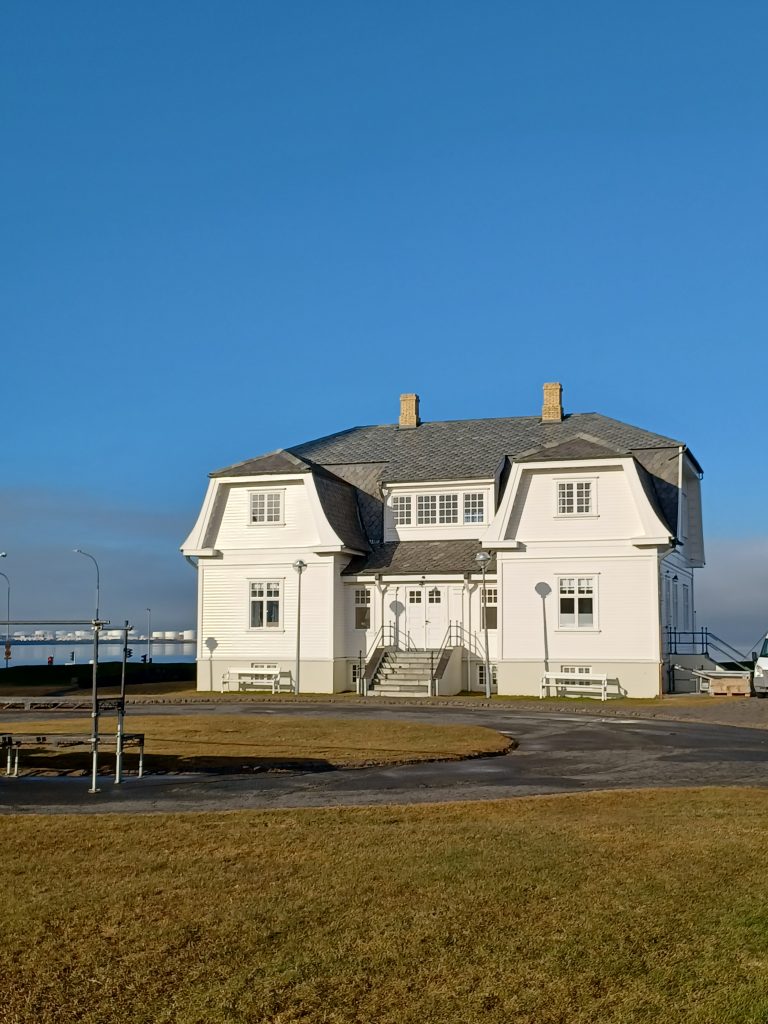
Harpa
I take the path along the coast road. Some gulls are floating about on the sea close to the coast wall and the newish concert hall, ‘Harpa’, sparkles in the distance. This building appears to be completely constructed out of geometric shaped windows, made in China, which reflect the light so that they flash in different colours. I was not a fan of the building at first as it seemed so enormous with its gleaming quadrilateral parts perched on the edge of the old harbour. But it is growing on me. A significant landmark it certainly is, and has won many awards for its architecture. Harpa was built during and after the 2008 financial crash and construction could not easily be halted during this time, despite the unfortunate economic situation. It hosts the impressive Iceland Symphony Orchestra and its acoustics are first class. Many a concert I have attended here.
‘Sólfar‘, Sun Voyager
As I continue my walk towards Harpa, I stop at the striking silvery sculpture, ‘Sólfar‘, Sun Voyager, by Jón Gunnar Árnason, specially positioned on the edge of the bay. On the accompanying plaque it is described as a dream boat, ‘promise of undiscovered territory, a dream of hope, progress and freedom‘. It looks a bit like a Viking long ship with its long silver steel prow pointing northwards towards Mount Esja. I love it. So, clearly, do the many travellers here today, many of whom are posing for photographs alongside. Shame the clouds are now obscuring the mountain. The weather in Iceland is anything but predictable.
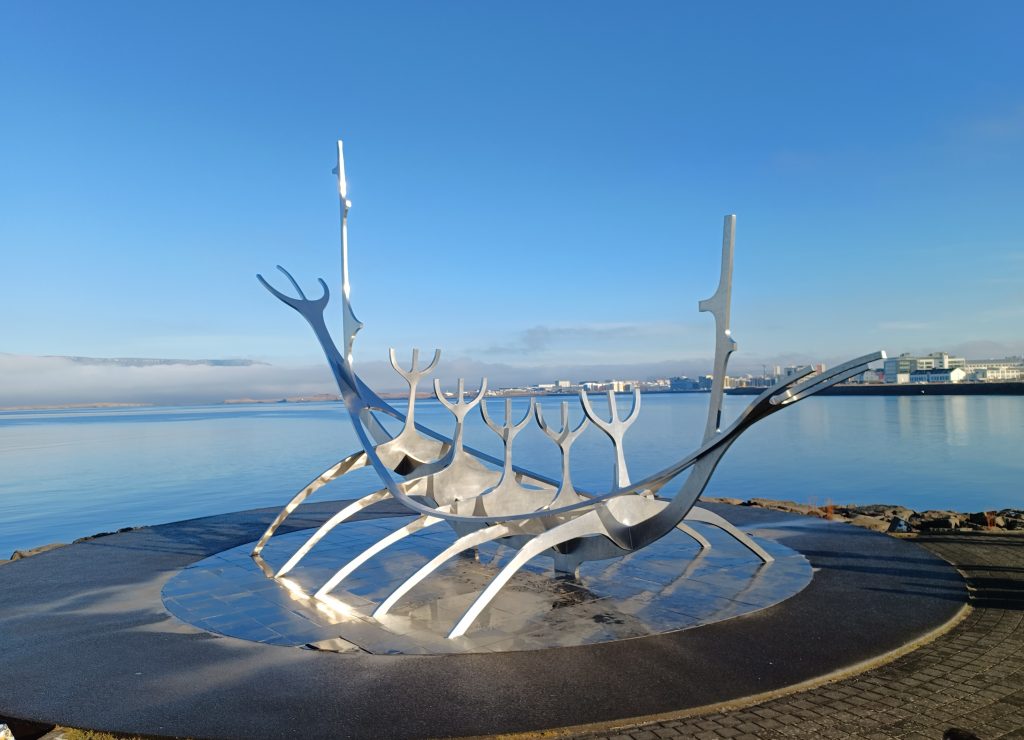
Reykjavík Harbour
In front of Harpa is the small road to the harbour entrance and the pontoon where Reykjavík‘s yachts are moored. I used to crew one of those yachts in races around the bay. Long time ago. I wander towards the port navigation light this side of the entrance. This marked the end point of the races and someone would be standing there firing the finish gun and noting the names of the winners. Today some lads are fishing here. I linger awhile.
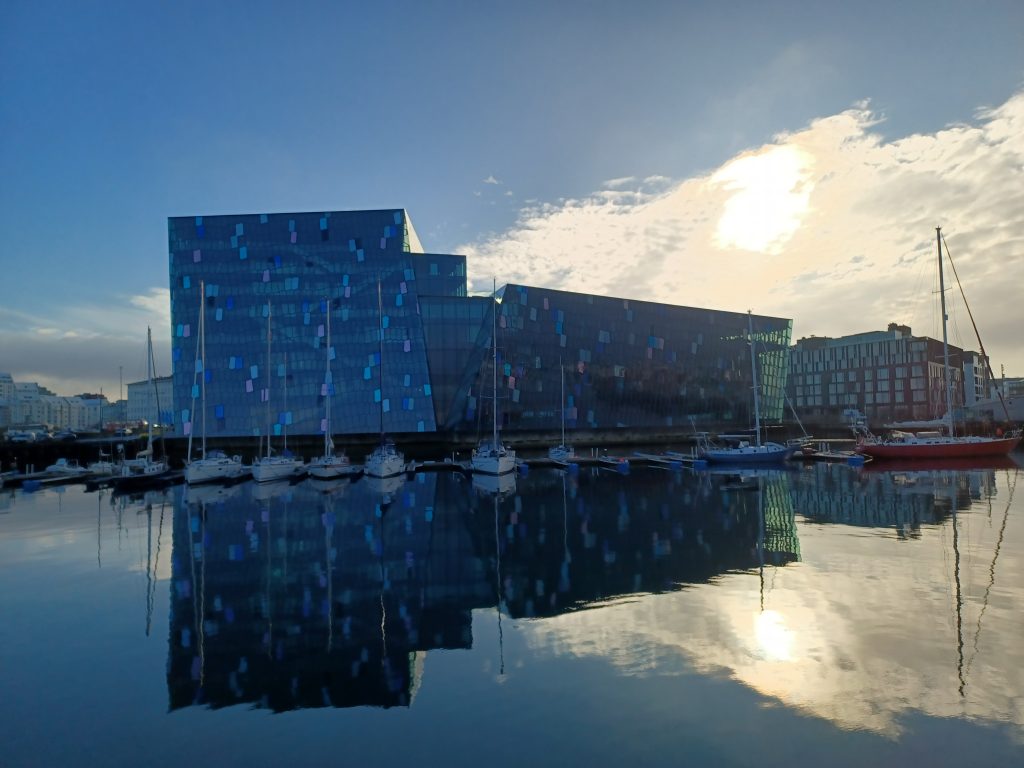
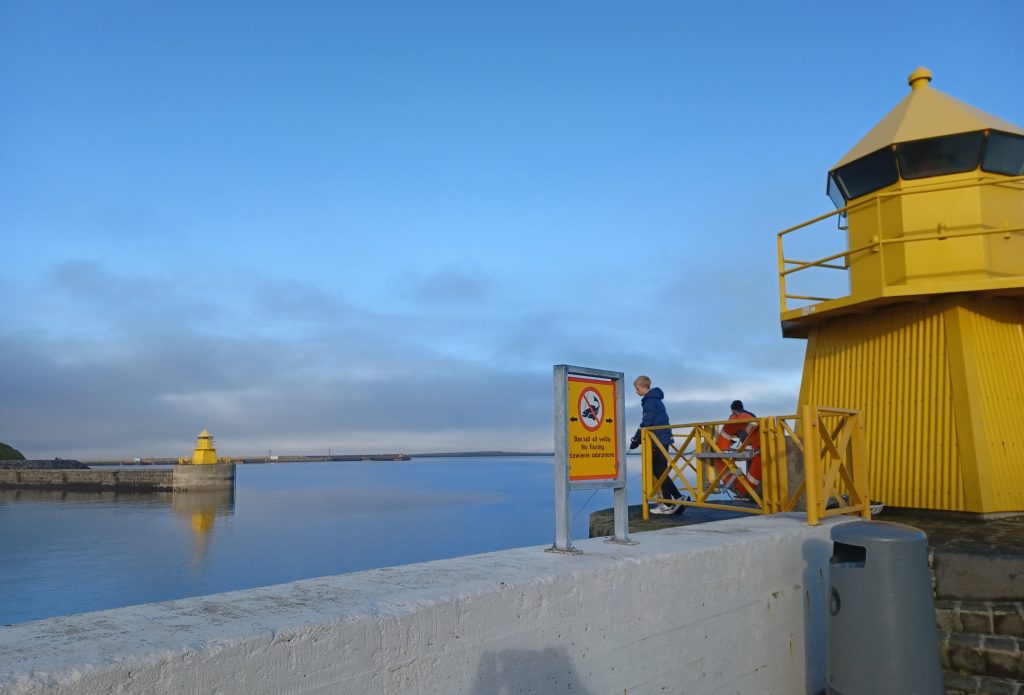
I retrace my steps past Harpa and veer onto the quayside past the Icelandic Coastguard vessels and new apartments blocks towards the old quays, around which the city grew up. There are many boats here. I like boats. They used to be fishing boats mostly, the harbour being the centre for the fishing industry, but now many take tourists for whale-watching trips and tours to offshore islands for puffin spotting. The whole area has been transformed in the last twenty years or so. I go into an old fisherman’s warehouse painted bright green, now a café, for seafood soup – delicious ‒ and sit at the window watching the visitors wandering around the quaysides.
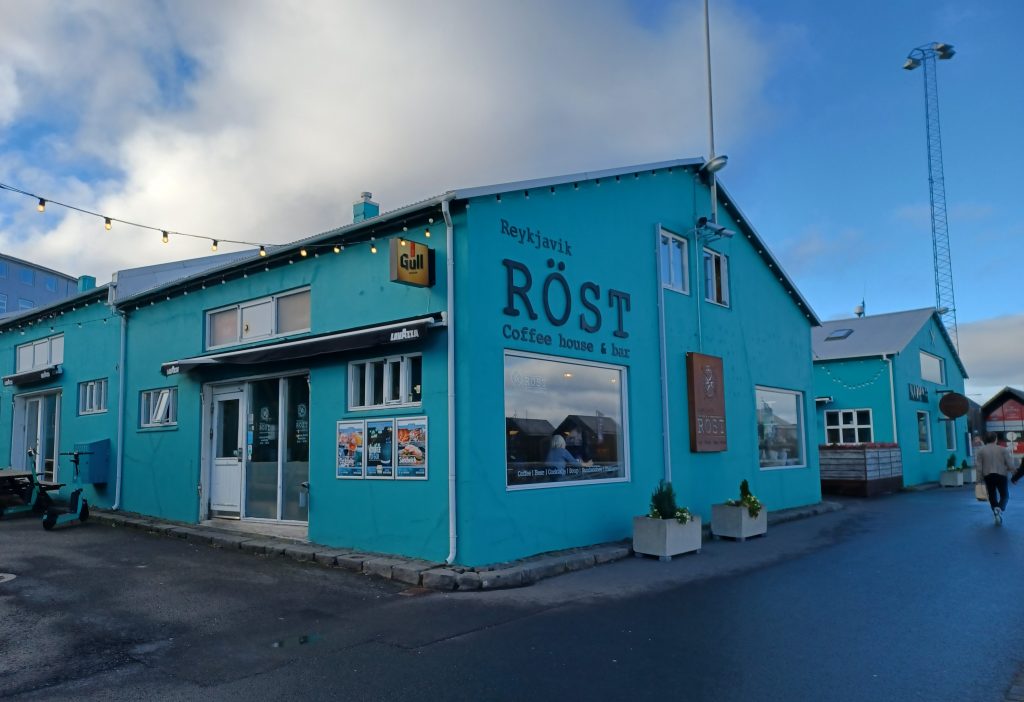
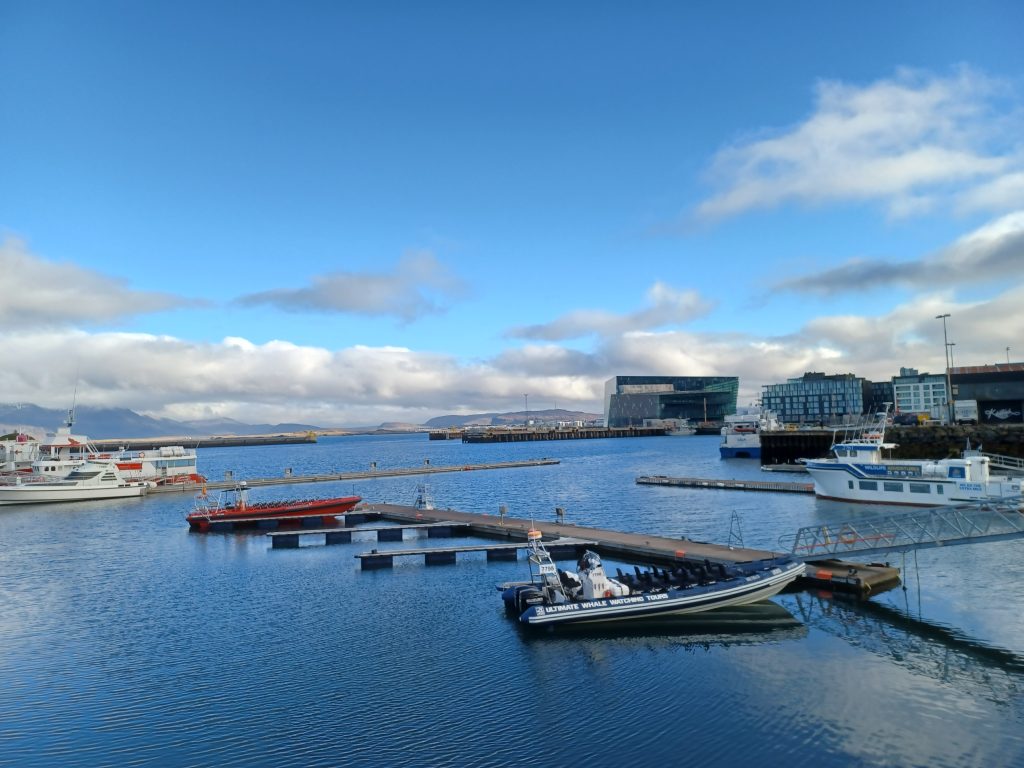
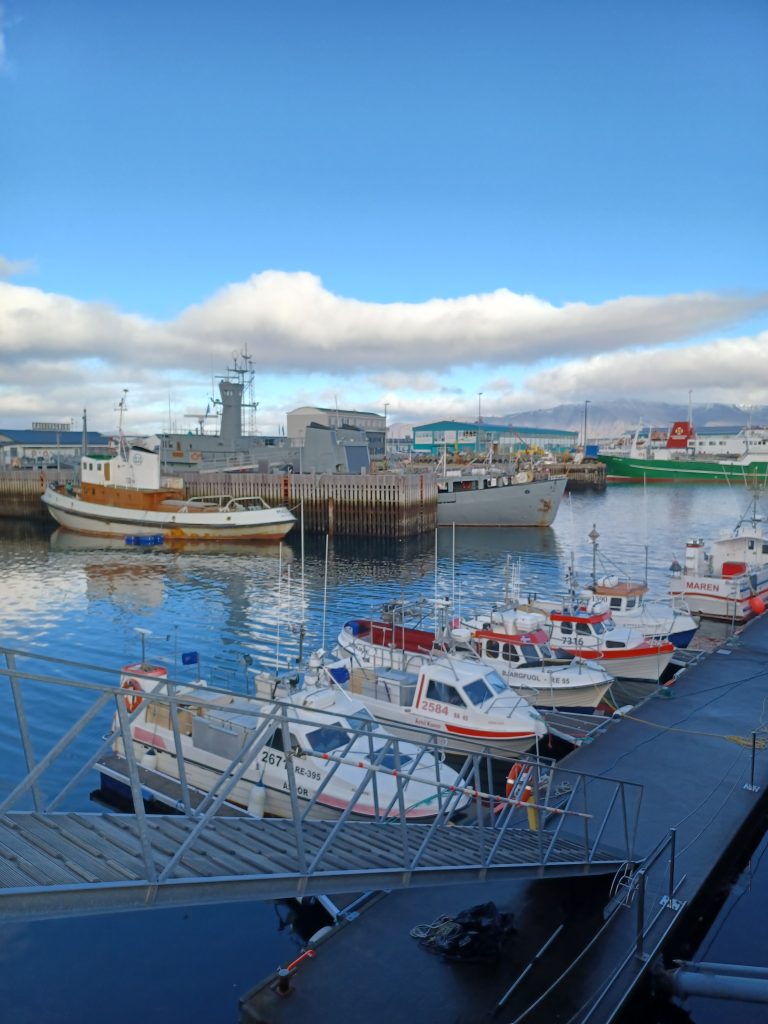
Squatting alongside one of the quays in the old harbour are two old whalers, run by the last remaining company to hunt whales in Iceland. In 1986 two whalers were sunk by activists from the environmental group, Sea Shepherd. Caused a bit of a hoo-ha and made the international news headlines. Said activists had got on board the whalers and extracted the sea cocks. In protest at Iceland’s defiance of a moratorium on whaling by the International Whaling Commission. Whaling is still controversial but the company abides by the quotas determining how many whales they are permitted to catch, only fin whales, I understand. I am not sure what is done with the whale products. Exported to Japan perhaps. Whale meat is not considered as ‘good’ to eat by Icelanders themselves as it once was. No doubt this is due in some part to the stigma associated with killing whales and many people prefer to pay to watch them than to pay to eat them. A few restaurants still offer it — to curious tourists mostly.
Maritime Museum, Reykjavík
The Maritime Museum, housed in a onetime fish freezing plant, is located on the harbour too. I wander past a shipyard and bars and a hotel to get to it. There is an old wooden trawler with a yellow hull sitting in front of the museum. Most such trawlers were decommissioned in the 1980s and 90s, their quotas transferred to more modern steel vessels. My husband acquired one of the old wooden ones, like this one, and we motored it to UK in the early 1990s, but that’s another story.
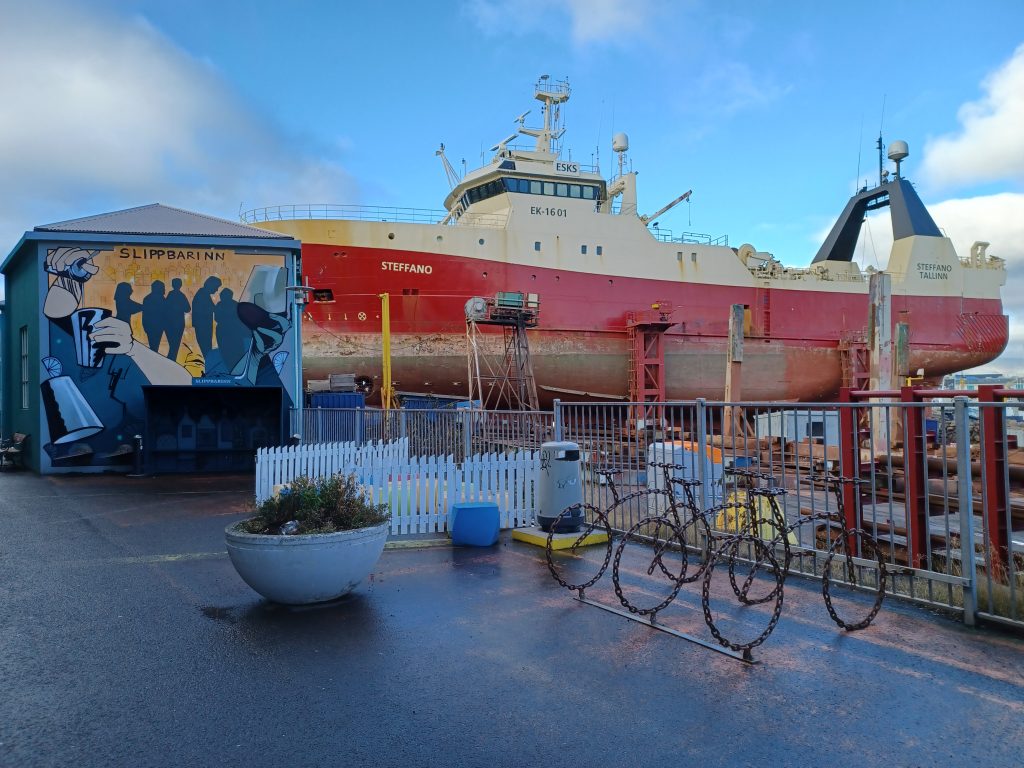
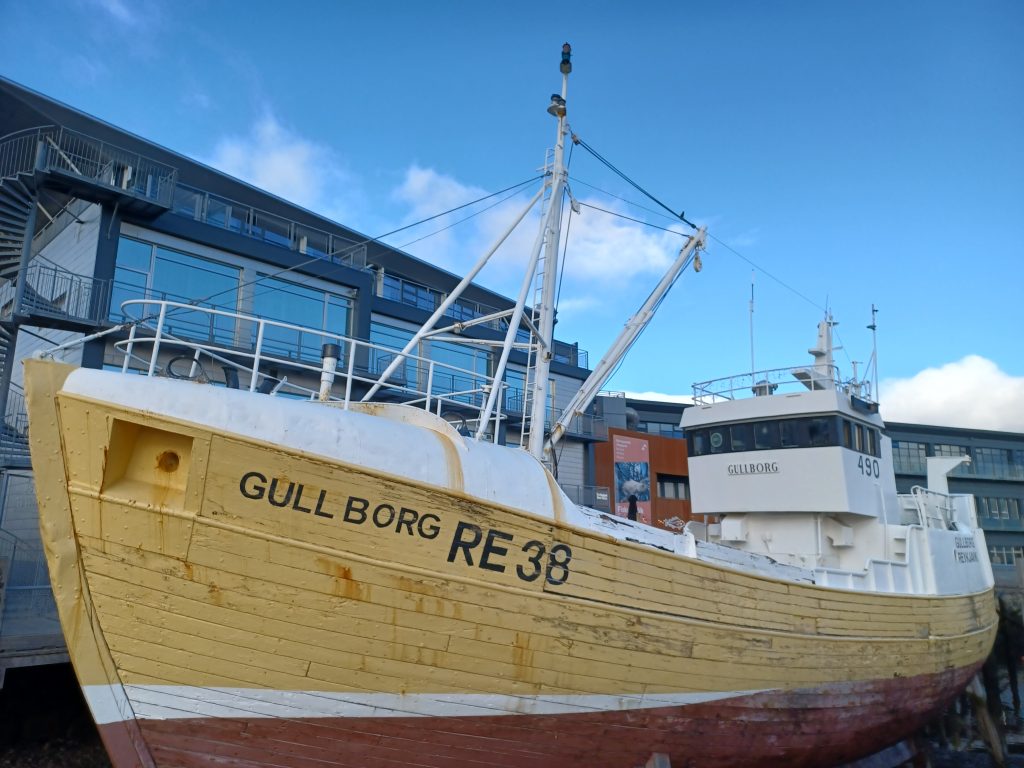
On a separate jetty lies one of the museum’s chief exhibits, the former coast guard vessel Óðinn (Odin). No doubt some readers will remember the three Cod Wars over fishing rights between Iceland and the UK during the periods 1958-61, 1972-73 and 1975-76. The British had refused to recognise the territorial fishing limits that Iceland imposed, first from four to twelve nautical miles (NM) in 1958, then fifty NM in 1972, then two hundred NM in 1975. Óðinn was used in all three of the Cod Wars and its reinforced ice breaking hull served it well in ramming British trawlers and Royal Navy frigates. The Icelanders had also developed net cutters with which to cut the British trawlers’ nets. Anyway, finally, in 1976, after the Icelanders threatened to close the NATO air base at Keflavík, the Americans put pressure on the British to comply with the demands.
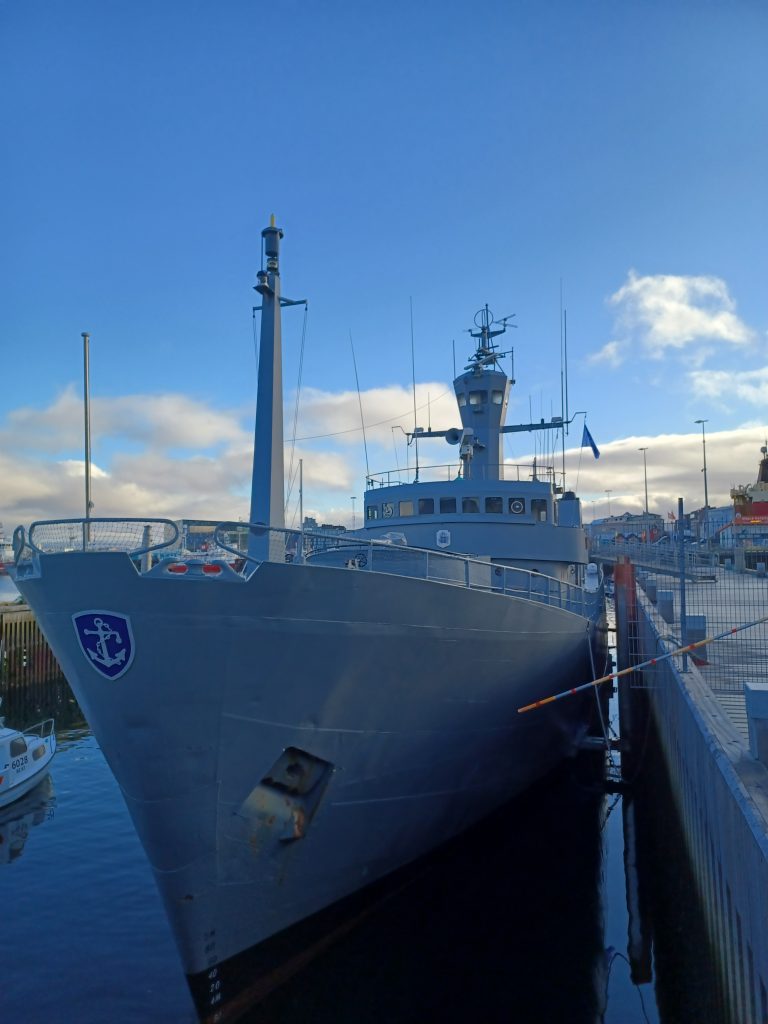
I never tire of mooching around the Old Harbour. So engrossing: boats buzzing in and out of the entrance, Mount Esja in the distance, Harpa concert hall, wooden cabins operated by companies offering tours to tourists; old vessels, new vessels, cafés, restaurants and animated people. Wander a little further behind the Old Harbour area and the traveller will find several other museums including: Aurora Reykjavík, the Northern Lights Centre, displaying the aurora borealis on the ceiling – in case you don’t glimpse it during your winter holiday; the Whales of Iceland museum with a load of life-size models of the whales found in Icelandic waters; and the Saga Museum, which brings the Viking age to life with the principle saga characters on display.
Old Reykjavík
Sauntering back from the harbour into the old town, I pass many old and attractive houses built of wood and corrugated iron. One is painted yellow, the top floor of which once housed the offices of a fish exporting business, where I worked on Vesturgata (West Street). The bottom floor used to be occupied by Álafoss, an old established company making woollen products.
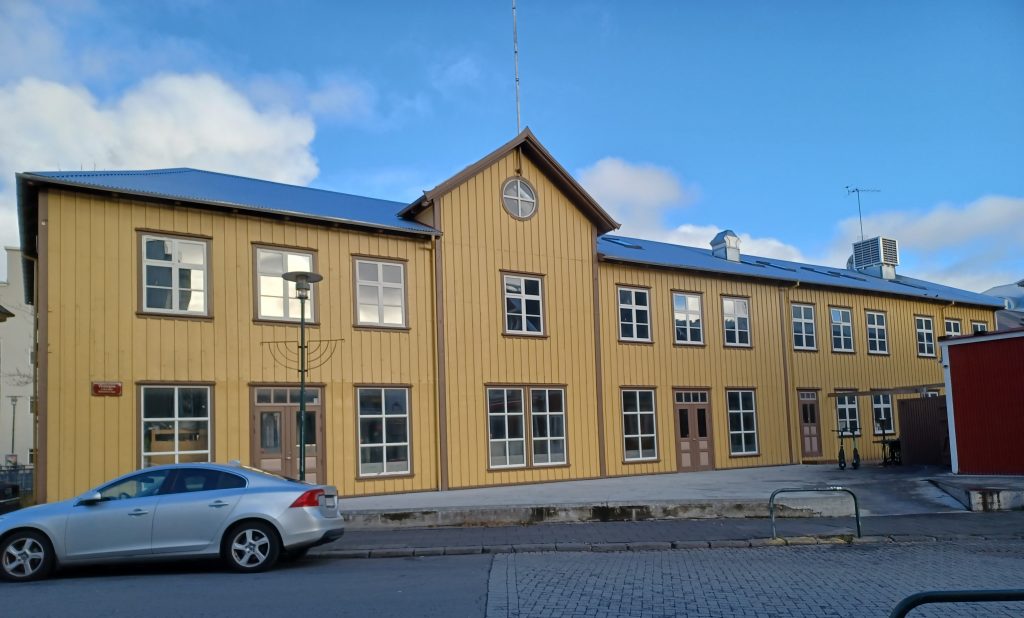
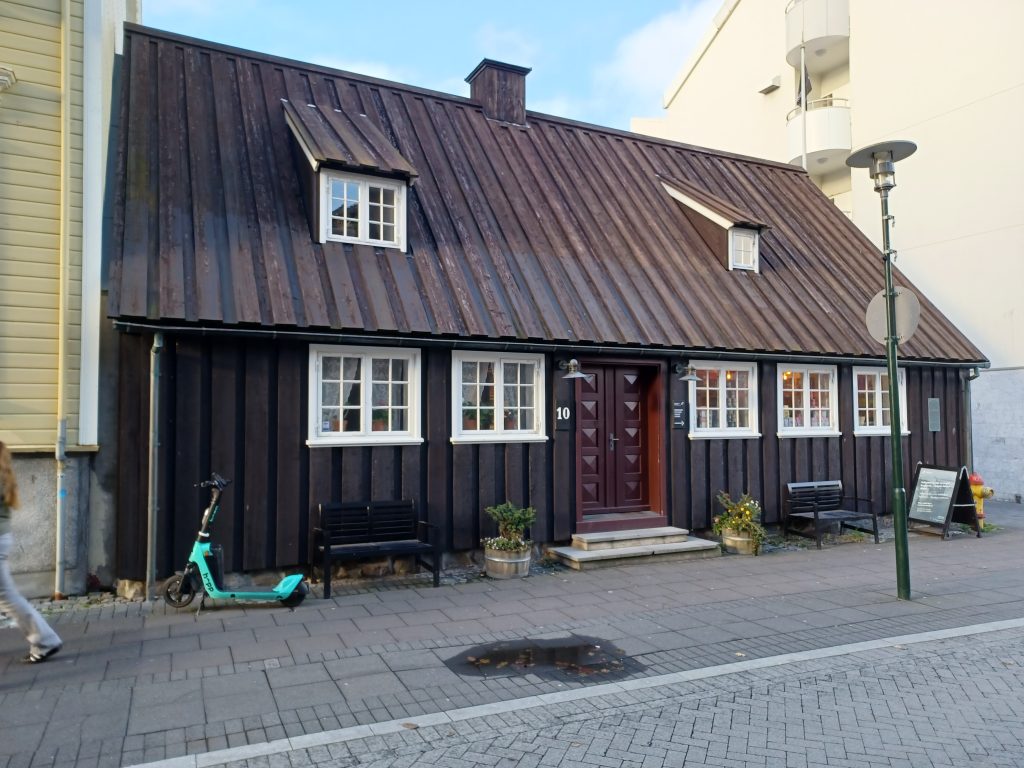
I continue along the main street (Aðalstræti) to see the oldest building in the city built in 1762. I gather it is now part of Reykjavík City Museum. Before that time most buildings were turf houses. In fact, the last residents to live in a turf house only moved out in 1966.
Some turf houses and farms have been preserved or reconstructed in Árbær open air museum, a couple of miles from the centre. This museum contains over twenty houses from the 19th century and a little church with a turf roof, where my daughter was christened.
Ingólfur Arnarson
The 871 +/-2 Settlement Exhibition is also located on Aðalstræti. Ingólfur Arnarson, a Norwegian nobleman, credited with being the founder of Reykjavík in c. 874, built a farm here and archaeologists unearthed a farm in 2001, deemed to be this one. According to the Book of Settlements (a medieval manuscript written in the 12th and 13th centuries), as Ingólfur approached Iceland with his wife and slaves in his long ship, he threw his high seat pillars over board and, following Viking custom, vowed to settle where they washed ashore. High-seat pillars were a pair of wooden poles placed on each side of the high-seat—the place where the head of the household would have sat—in a Viking house.
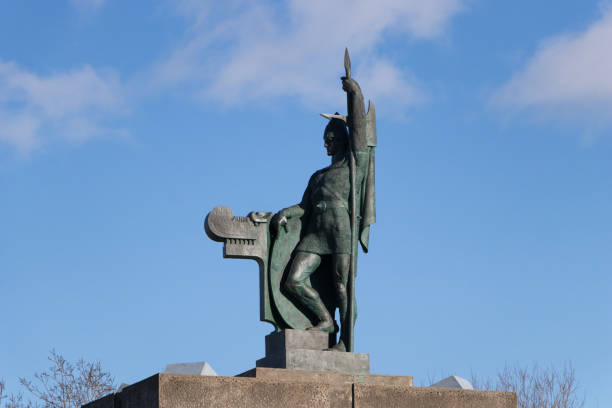
His slaves found them in Reykjavík (Smoky Inlet), so named by Ingólfur due to the steam emanating from hot springs in the area. There is a statue of Ingólfur Arnarson on Arnarhóll (Eagle Hill). Once overlooking the harbour, poor Ingólfur now oversees new apartment blocks and the new hotel and conference centre next to Harpa concert hall.
I wander on viewing other buildings of note in the city: Parliament house, built to house the national assembly after the Alþing was moved to Reykjavík from Þingvellir in 1798. Handsome building. Constructed from basalt, Iceland’s underlying rock, which accounts for the black sand on the beaches.
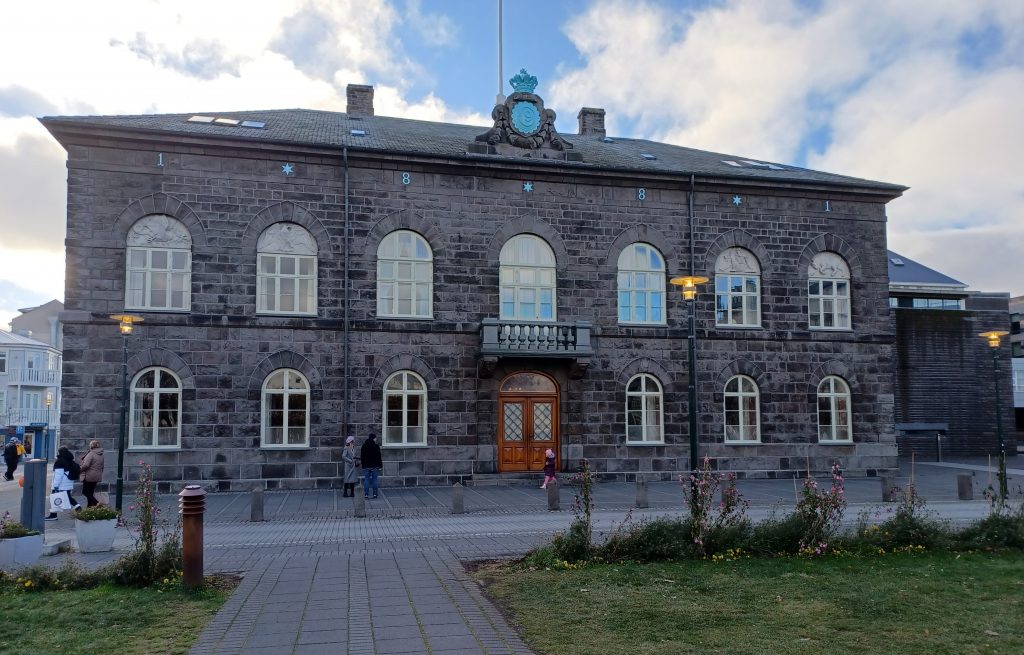
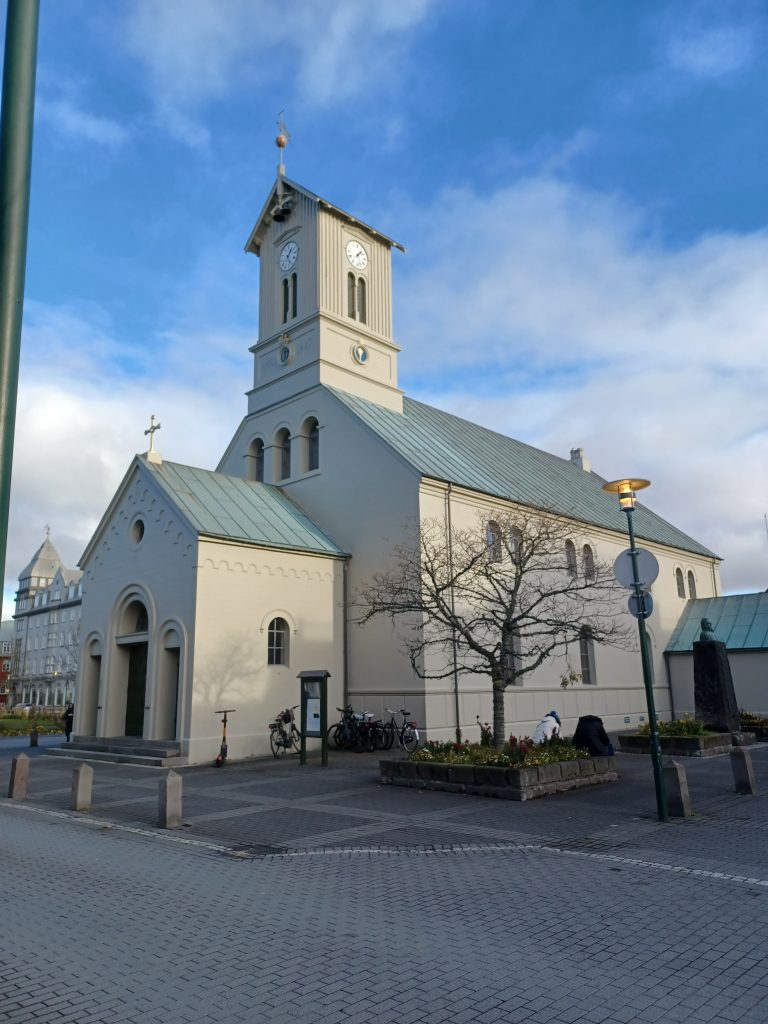
Around the corner is the Lutheran cathedral. I attended a wedding there once. Wistful memories. The Cathedral was completed in 1796 after the two bishoprics of Skálholt in the south and Hólar in the north, were abolished and amalgamated into one single diocese. Lovely old building.
Nearby, overlooking Reykjavík’s pond, the Tjörn, is the City Hall, built in the early 1990s following an international competition. Uncolourful and concrete. There is a patch of the pond – quite a large pond actually divided in two by a road ‒ here by the City Hall where some families are feeding the various ducks, geese and gulls which gather. I stop and watch the greylag geese cackling and the black headed gulls clamouring as chunks of bread are chucked into the water. Meanwhile some whooper swans waddle onto the cobbles to grab what they can.
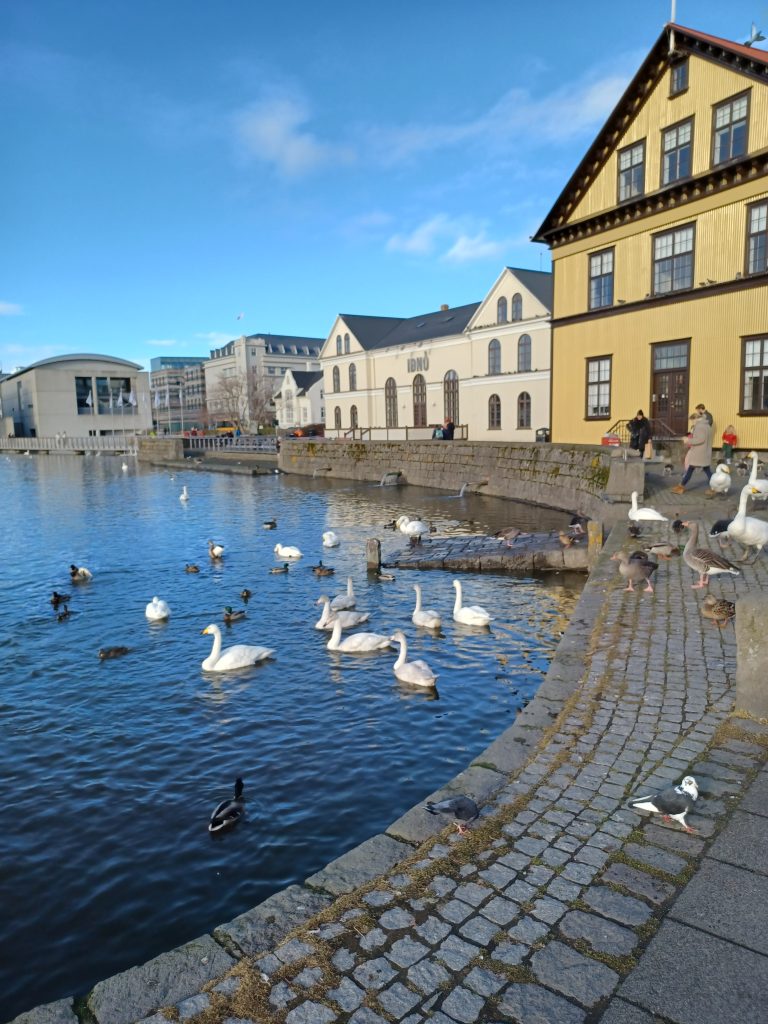
Between bird feeding corner and the City Hall is a statue of a man carrying a briefcase. In place of his head and torso is a massive lump of volcanic basalt. A blockheaded bureaucrat? I believe its correct title is ‘Unknown Official’ by Magnús Tómasson. Much photographed. There are weird and wonderful artworks all over Reykjavík, especially around the Tjörn, strategically placed between flower borders or sitting on seats. The Mermaid, ‘Hafmeyan’ in Icelandic, sits in its silvery sheen on the water though. By Nína Sæmundsson, made of bronze on a granite block. The ducks seem to like her. Me too. The National Art Gallery is located by the Tjörn too, in the premises of what once was the Ice house. Splendid art works within. There are art galleries and sculpture collections all over the place in the Capital. No shortage for the enthusiast.
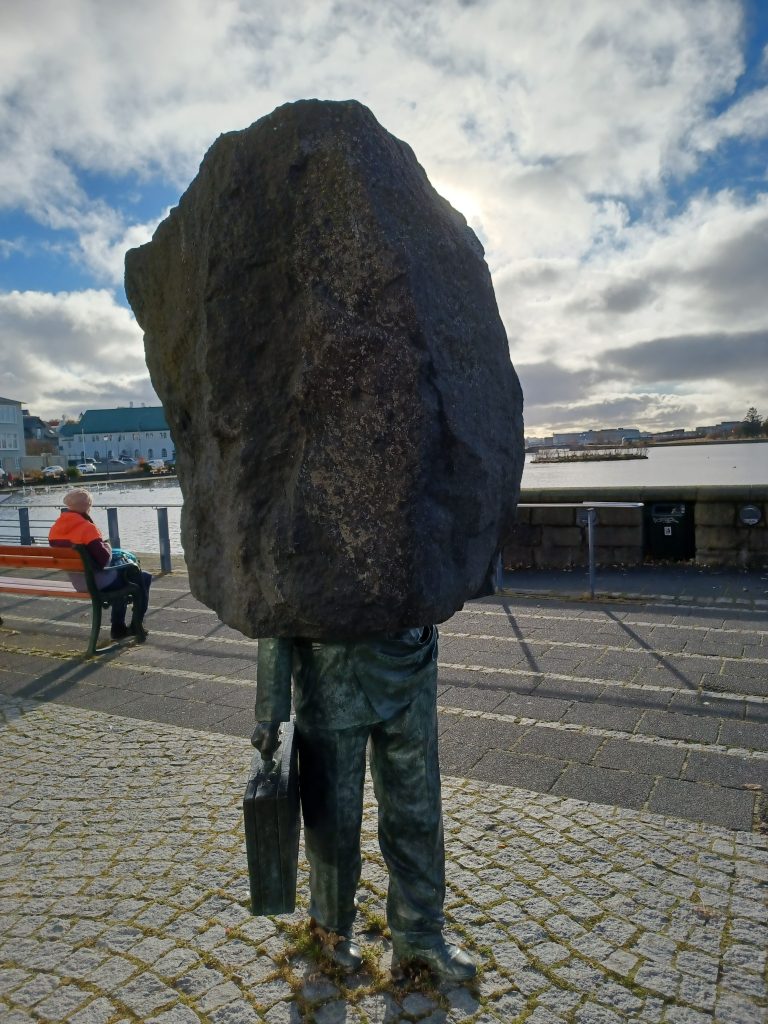
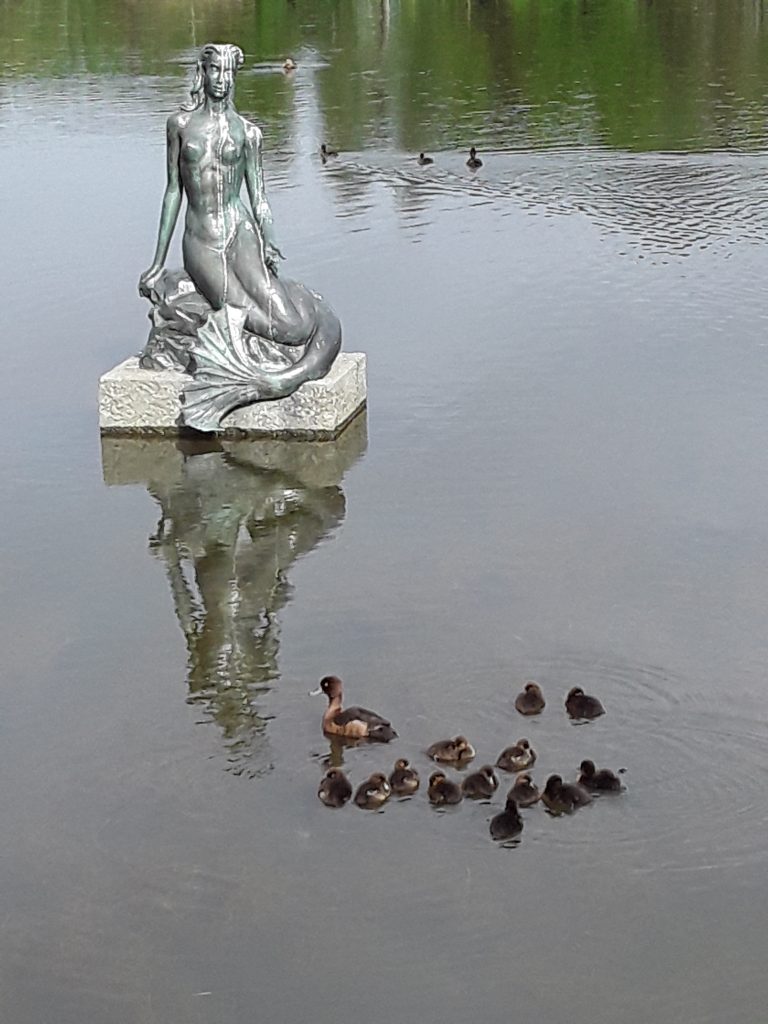
From the Tjörn I head towards Government House, which started life as a prison and now houses the Prime Minister’s offices. Two statues stand proud in front of it, both sculpted by Einar Jónsson. One is of the Danish King Christian IX – he who presented Iceland with its ‒ limited ‒ constitution in 1874, and the other of Iceland’s first Prime Minister, Hannes Hafstein. And, to the right of Government House at the road junction is the Punk museum, located below street level in what were once the public toilets. A curious change in use. The museum is situated in front of one Reykjavík´s best restaurants. It is called Lækjarbrekka and specialises in Icelandic cuisine. Not the cheapest eatery in town but then dining out in Iceland is seldom a low-cost experience.
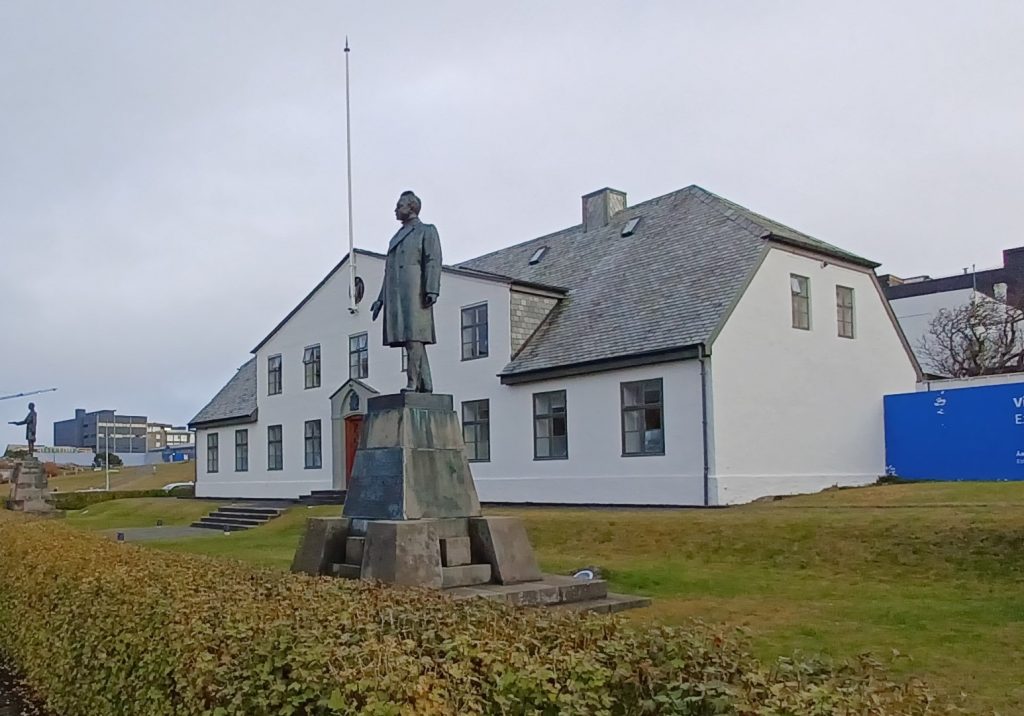
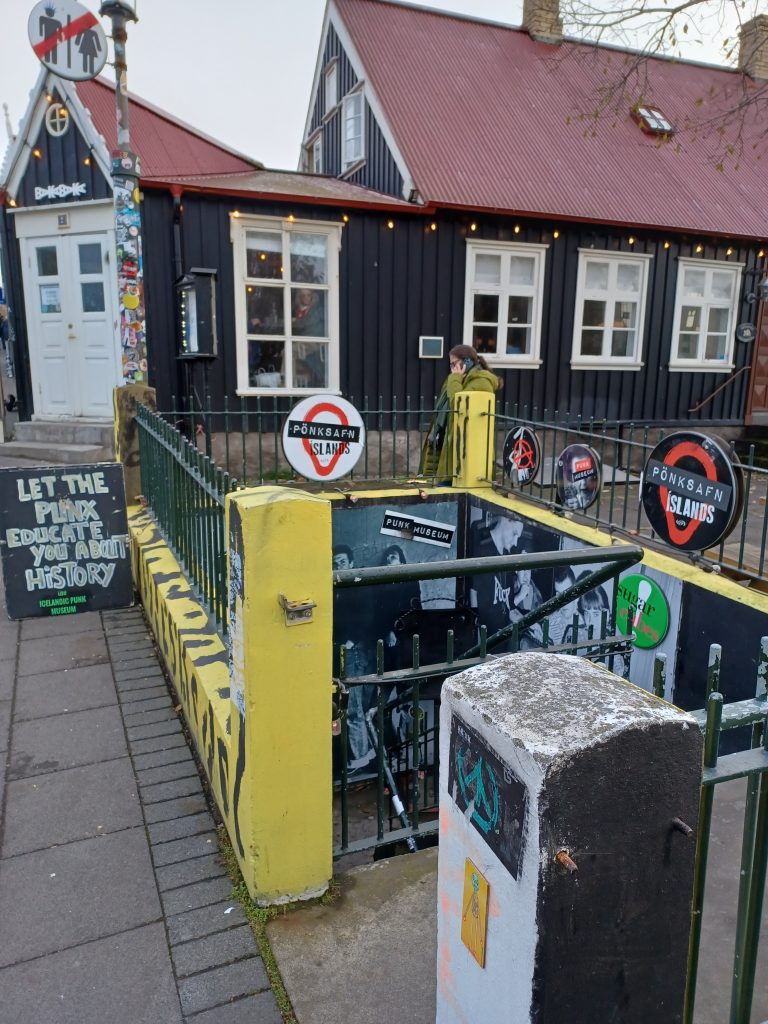
Other museums are dotted round the city, including the National Museum, which contains archaeological finds from the Viking age; and the Icelandic Phallological Museum. Something for everyone.
Souvenir shops, fashion shops, cafés and bars abound in the old streets of Reykjavík. One of Iceland’s main products being wool from their vast numbers of sheep, souvenir hunters can find woollen blankets with horse and sheep designs, sheep skin rugs, and knitwear products, such as traditionally designed jumpers, hats and scarves. Viking warriors, long-ships and drinking horns entice passers by. A young boy is holding court in one shop, demanding a Viking warrior from his frazzled parents. Said warrior is sporting horns on his helmet, a complete fallacy by the way. The parents give up the struggle for the sake of peace. Away from the main tourist areas are quiet streets with colourful houses. Soothing it is strolling round these old areas of Reykjavík,
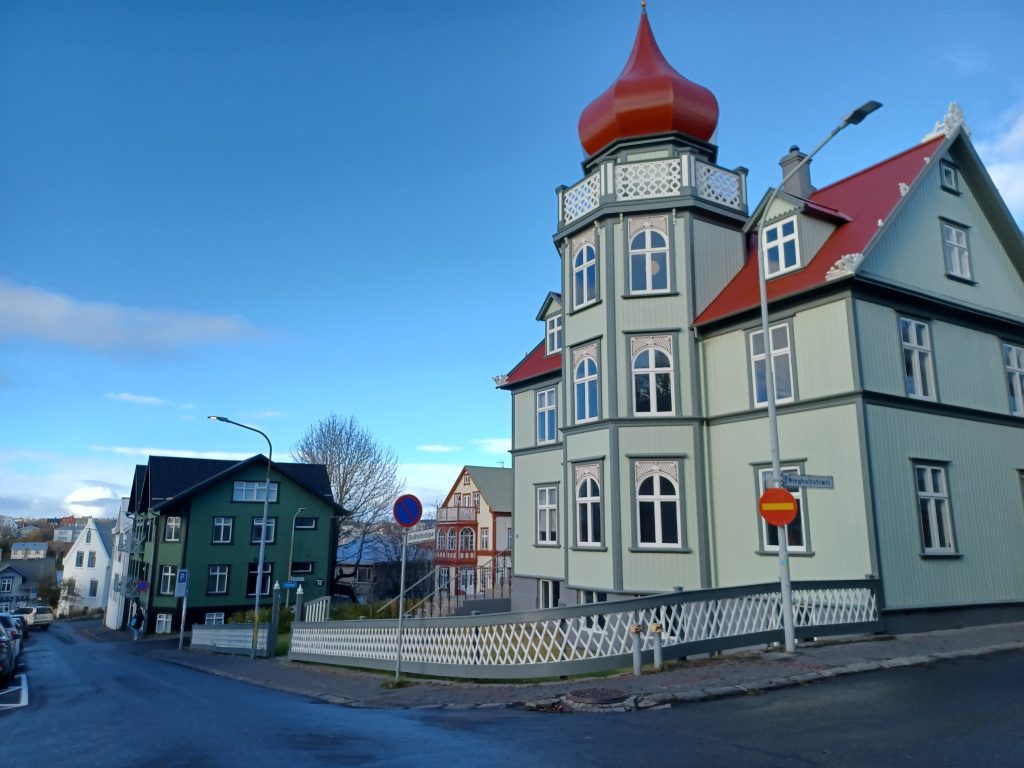
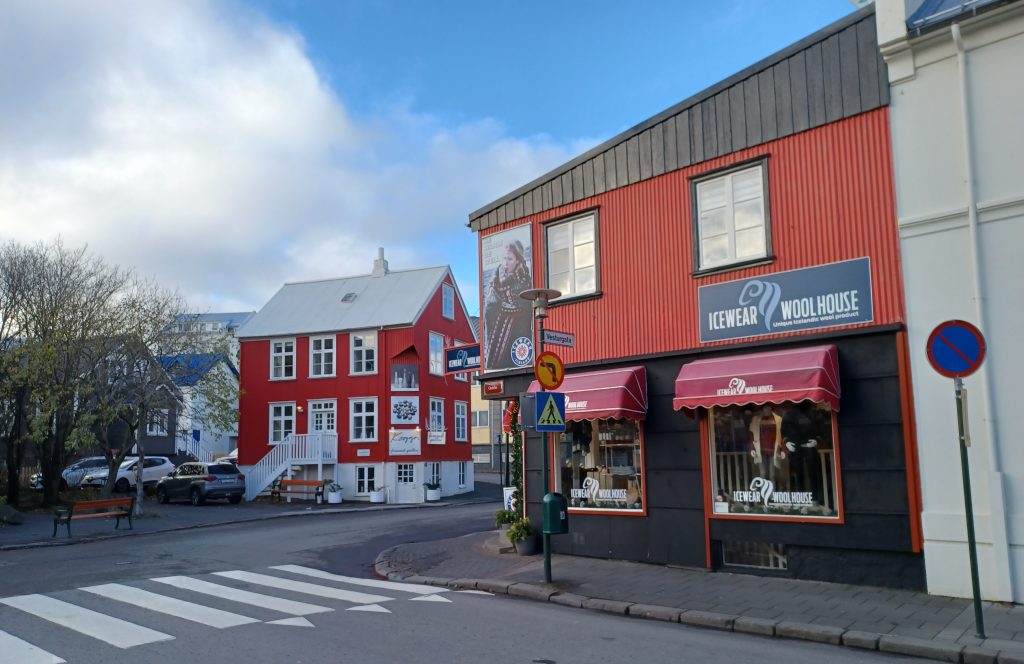
From the old city is a short hike up the hill and home. My route heads towards Hallgrímskirkja, Hallgrím’s Church, the largest church in Iceland, which towers over Reykjavík. Designed by one of Reykjavík’s best known architects, Guðjón Samúelsson, it is actually a parish church – Lutheran‒ constructed so as to evoke the basalt columns of the Icelandic landscape, and was named after the 17th poet, Hallgrímur Pétursson. It is staggering, though stark, to look at. Standing 74.5 m high it took forty years to build, from 1945 to 1986. Within, it is plainish and grey but has a wonderful organ designed by the German organ builder, Johannes Klais of Bonn. Many concerts are performed here, particularly by choirs. A couple of my friends sing in them.
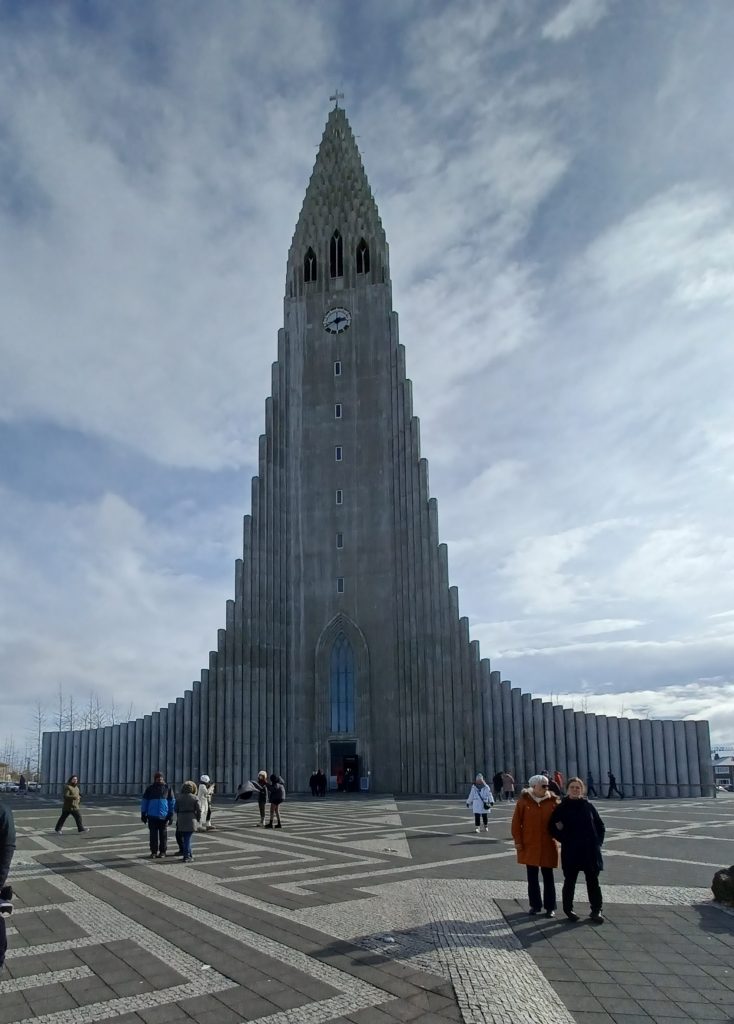
In a commanding position in front of the church is the statue of Leifur Eiríksson, son of Eirík (Eric) the Red, who settled Greenland and who, according to Eiríks saga, was the first to discover America in about 1000 AD, five hundred years before Columbus. I stop to gaze up at it. It predates the church in fact, the Americans, having gifted the statue to commemorate the one thousand years of the Alþing, insisting on this preeminent position on the hilltop. It is a popular selfie taking spot. Some Chinese tourists are there and wish to include me in a photograph. Can’t think why but I oblige them and conjure up the necessary grin. I descend the hill towards my son´s flat. Quick cuppa there and I am off again.
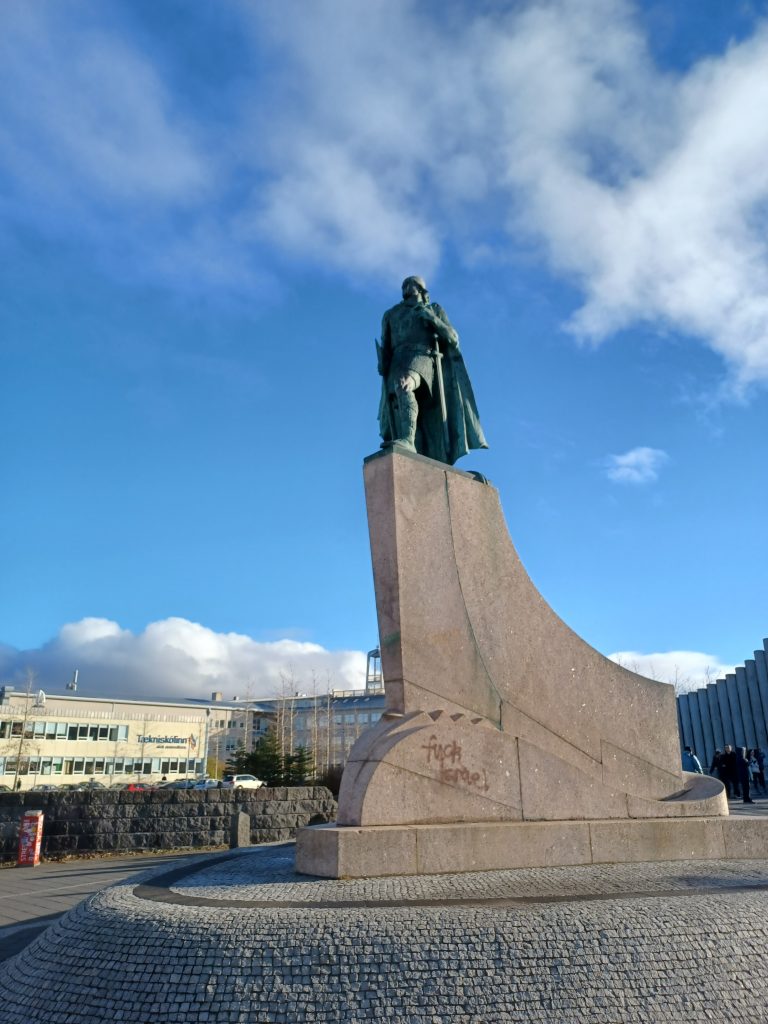
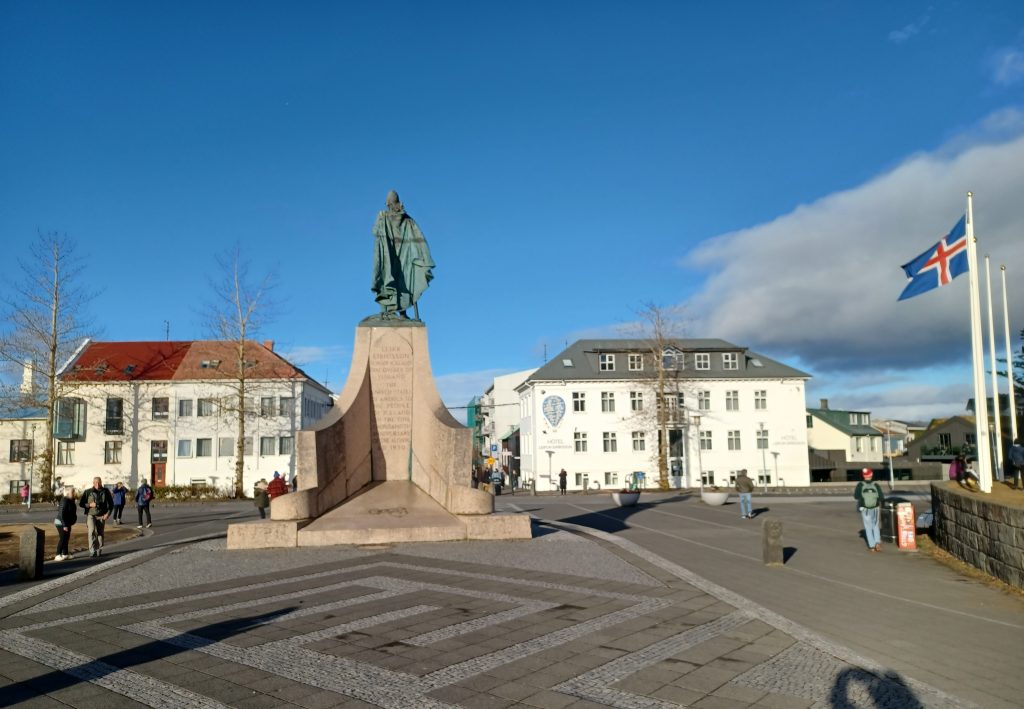
I head south through Klambratún park past the wonderful art gallery named after one of Iceland´s foremost artists, Jóhannes Kjarval. Many of his paintings depict images of the Icelandic landscape. One of my favourite artists. No time to stop today as I am on my way to meet some friends.
Perlan
I have arranged to meet them this afternoon at ‘Perlan‘, the Pearl, atop Öskjuhlíð hill in Reykjavík. A favourite stop for tour groups with scenic views over the city and the surrounding bay. The building itself is rather fascinating too. The Pearl was built in 1991 on top of six hot water tanks. Atop the tanks is a huge glass dome under which is a revolving restaurant/café. At least, it was once revolving but it isn’t at the moment. If you wish, you can pay to walk around the outside of the dome. Free to explore otherwise. But first I stop to look at the sculpted figures outside the main entrance: ‘The Dancing Musicians’ by Þorbjörg Pálsdóttir. Quirky. I like them.
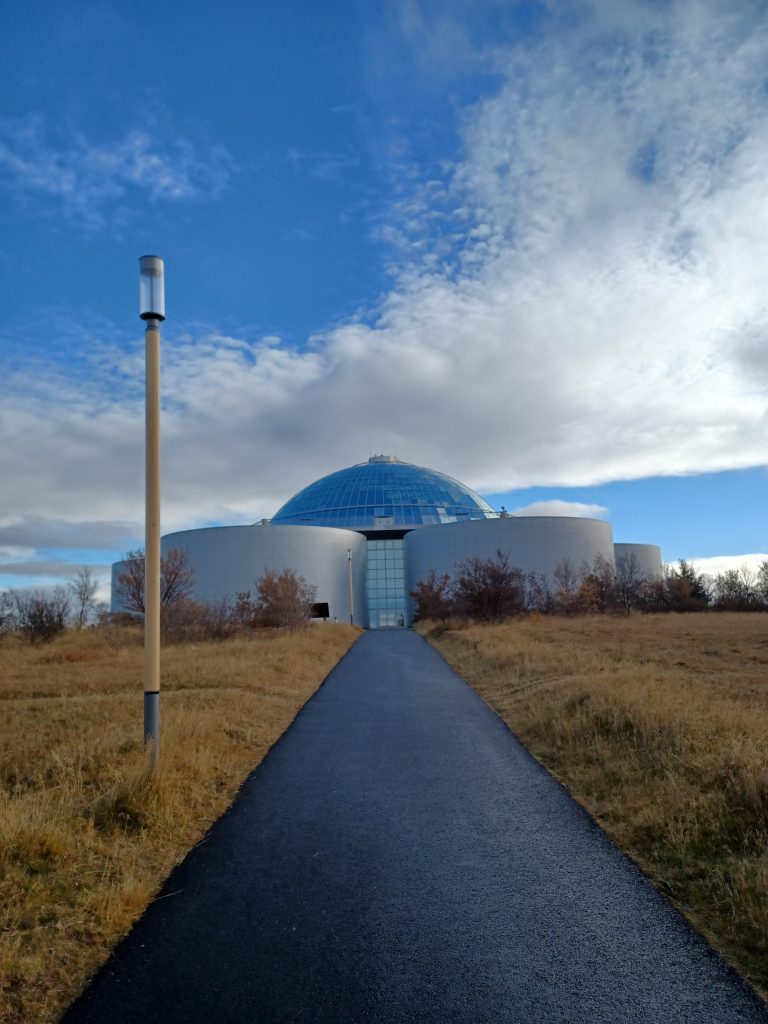
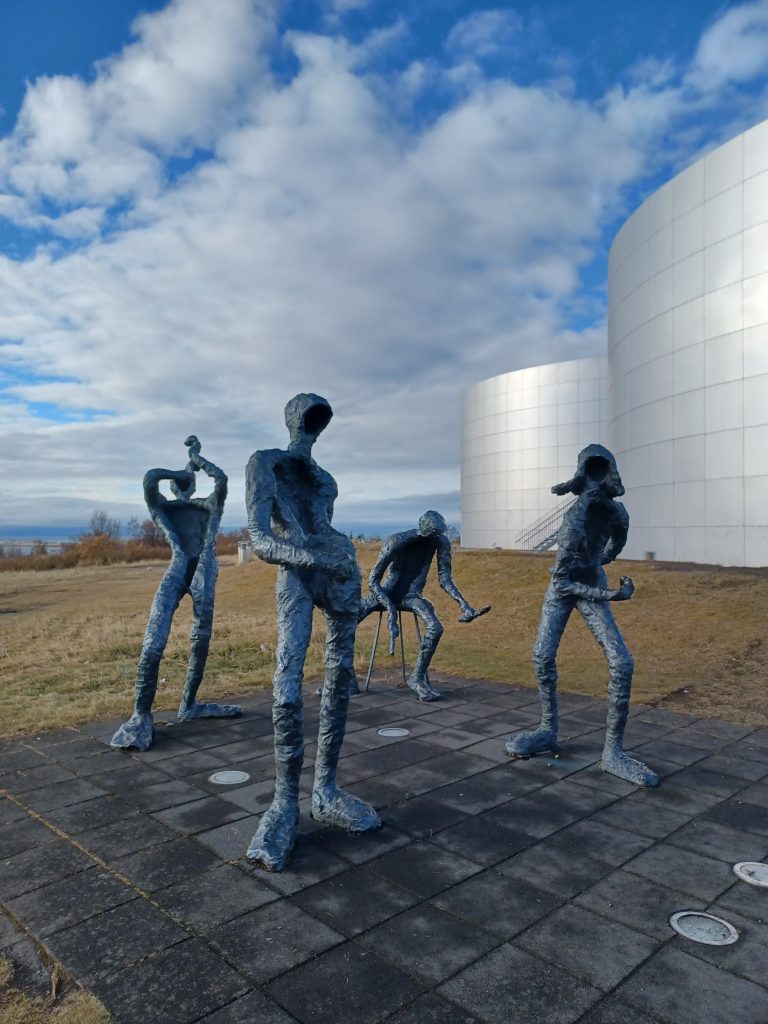
Exhibitions are held in Perlan too, about such topics as natural history and the environment. At one time the Saga Museum was housed in one of the tanks before moving downtown to the Old Harbour area.
Reykjavík Airport
Before refreshment, we wander over to look down upon Reykjavík airport. A placard tells visitors about how, during WWII, the British Army built this airport after they occupied Iceland in 1940. From here the Royal Air Force was able to provide protection for the convoys crossing the North Atlantic to Britain with vital supplies. Nissen huts were built lower down the hill for accommodation. It is a wonderful area to explore with many trails and trees and remnants of the defence post with its concrete pill boxes. There were about 50,000 British, American and Canadian troops stationed here in 1943 (See also my travelogue on Iceland: the Golden Circle and Blue Lagoon).
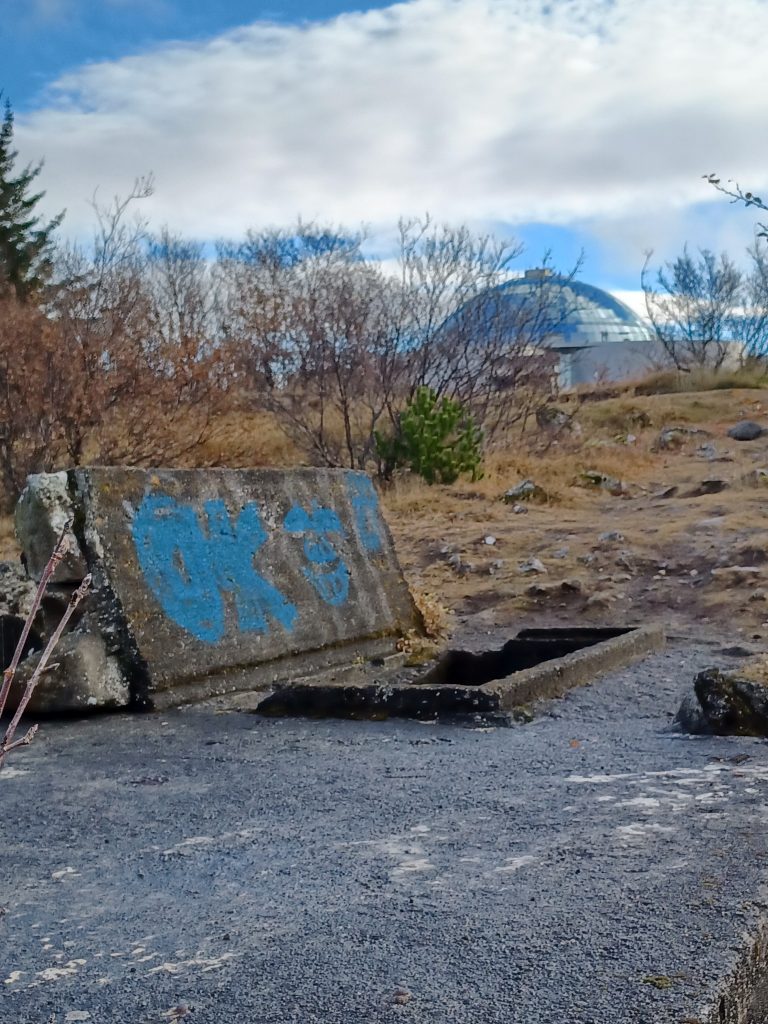
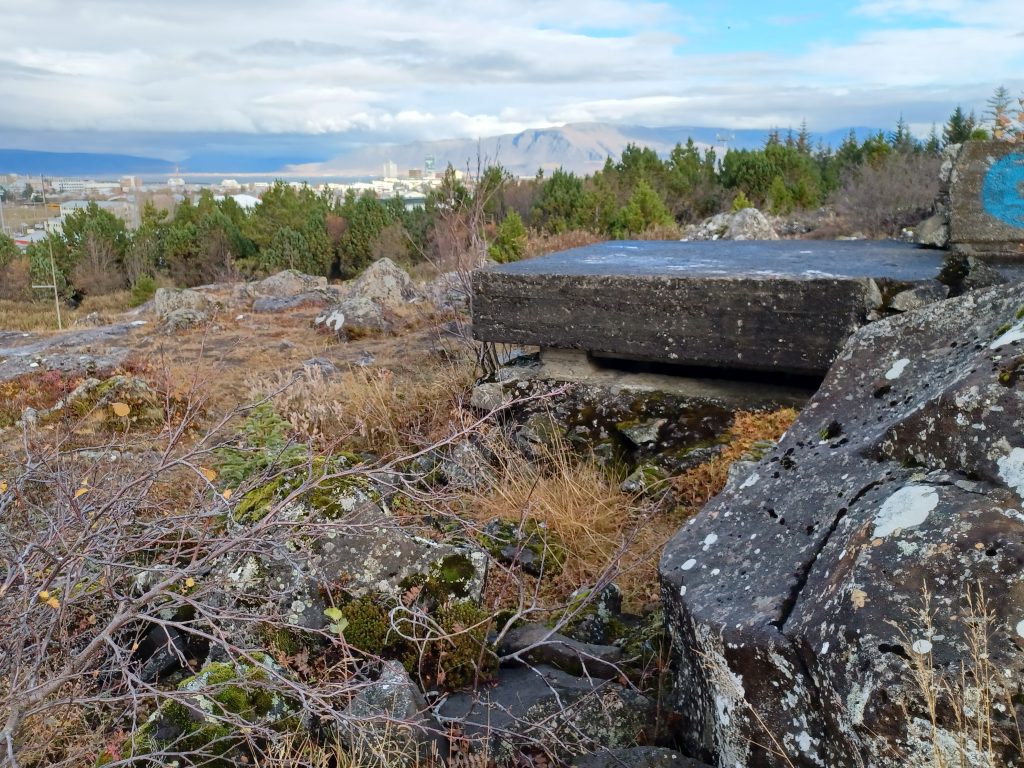
My friends and I lounge in Perlan’s café and converse over drinks. The sun is hovering on the horizon when we wander down the track to the carpark. We say our goodbyes. Tomorrow I am heading home. But I will be back again.

Leave a Reply